|
|
 Camera Equipment Review... Sigma 500/4.5 HSM-EX
Text and Photography Copyright Jim Erhardt
“Super-telephoto” is a term generally applied to prime lenses with focal lengths of 300mm or greater. While there are many zoom lenses available at reasonable cost that exceed 300mm, few, if any, provide the lens speed and image quality available with a prime lens. Unfortunately for nature photographers, super-telephoto lenses are not inexpensive, especially beyond 400mm in length and faster than f/5.6. The major camera makers offer their versions of 400/2.8, 500/4.5 and 600/4 lenses with prices in the $6,000 to $10,000 range. While these lenses are the ultimate for wildlife photography, very few of us can afford or justify such a large expenditure for a camera lens. For those of us who use 300/4 telephoto lenses with teleconverters, we know that we can successfully capture great wildlife images with these lenses without having to “break the bank.” We also understand the limitations of these lens/teleconverter combinations and know that the next step up is a huge one, one that most of us will never have the opportunity to make. Having spent over $1,500 on a Canon 300/4L and the Canon 1.4X teleconverter, the $6,000 plus jump to their 500mm or 600mm lens will remain only a dream for me. When the opportunity to field test the Sigma 500/4.5 HSM EX super-telephoto lens arose, I naturally jumped at the opportunity. Here was a chance to see what the extra 80mm in focal length and two-thirds of a stop in lens speed would gain. While I thought the gain over a 420/5.6 lens and teleconverter combination would be only modest, what I was about to experience was truly eye opening.
Initial examination of the lens revealed very high quality construction. The smooth turning, well-damped focusing ring of the HyperSonic Motor mechanism immediately impressed me. Like Canon’s ultrasonic and Nikon’s silent wave lenses, Sigma’s HSM motor is touted to provide fast and silent autofocusing with full-time manual over ride. The design and operation of the very substantial tripod collar, which turned as smoothly as the focusing ring, also impressed me. Even with the F100 mounted on the lens, it turned very smoothly without any looseness or wobble. When the collar’s locking knob was tightened, the lens was held securely. The lens also uses a unique ring for rotating the 46mm filters that are inserted at the rear of the lens. Instead of the usual knurled wheel, the ring is easy to reach and turns smoothly with a nicely damped action. The lens also features a 3-position focus-limiting switch, selectable to 4 to 8-meters, 8-meters to infinity and 4-meters to infinity. The lens barrels are constructed of magnesium alloy and feature a very attractive black matte finish. The lens hood is made of a composite material and secures to the front of the lens via a bayonet mount. The optical design is made up of 12 elements in 9 groups, including 2 ELD elements that rival fluorite in optical quality and a hard-coated protective element in the front. 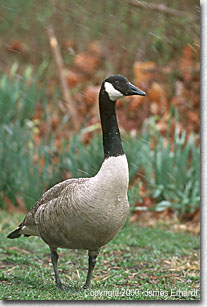
In The Field Larry and I visited Connetquot River State Park that Sunday, even though the weather was far from co-operative. Neither rain nor snow stopped us from venturing out with equipment over shoulder, protected in heavy-duty plastic garbage bags. We made our way to one of the buildings on the property and set up in a protected area under a porch overhang. As the weather continued to deteriorate, we set up the equipment and waited for some photographic opportunity to appear. As I began to scan the area through the viewfinder, I immediately noticed the speed and silence of the Sigma’s HSM focusing motor. In fact, this combination focused as fast and sure as my Canon 1n and 300/4L. However, the extra 200mm of focal length gave me far more “reach” than a 300. Even under these adverse conditions, the color and contrast of the lens was evident as I watched water droplets roll off the plumage of the Canada Goose. The sign on the old gristmill clearly demonstrated the Sigma’s wide-open sharpness, even through the driving snow.
Early Monday morning, I visited a local park inhabited by a large and diverse population of waterfowl. With a very limited amount of time available, my goal was to capture some birds in flight to see how well the Sigma could keep up with the action. With just a few frames remaining, I took what the birds were willing to give. The Slides
I guess it came as no great surprise that the results were extraordinary. In terms of sharpness, contrast and color, the slides were excellent. While it’s not a direct or even a relevant comparison, in autofocus performance, the F100/Sigma 500 combo performed as well or better than my Canon 1n with the 300/4 L. However, when compared to my equipment with the 1.4X teleconverter in place, the Sigma clearly outperformed it. It snapped into focus with far greater authority while providing a 80mm gain in focal length and two-thirds of a stop of additional shutter speed. Conclusion I now know why serious wildlife photographers will part with a pile of cash to own one of these super-telephotos. The short time I spent with this lens made me realize what a tremendous asset it is in the field for the wildlife photographer. I found the Sigma 500/4.5 HSM EX to be a perfect balance of focal length, lens speed and size. Its build quality, performance and handling leaves nothing to be desired. At an average in-store price of well under $4,000, it’s still a pile of cash but for me at least, brings the dream of owning a top-quality super-telephoto lens that much closer to reality. JE-NPN |
|
|
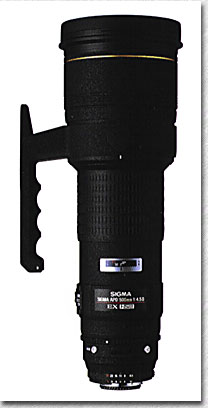 Successful wildlife photography places its own specific demands on both equipment and photographer. In our quest to “fill the frame” with the subject, we must learn the habits of our photographic quarry and practice the techniques of close approach, all without posing a threat to the subject. On the equipment side of the equation, we must use as long of a lens as possible so that we can fill the frame without having to approach the subject too closely. In many cases, the use of a super-telephoto lens is the only practical way to get the shot we want without endangering ourselves or placing undue stress on the animal.
Successful wildlife photography places its own specific demands on both equipment and photographer. In our quest to “fill the frame” with the subject, we must learn the habits of our photographic quarry and practice the techniques of close approach, all without posing a threat to the subject. On the equipment side of the equation, we must use as long of a lens as possible so that we can fill the frame without having to approach the subject too closely. In many cases, the use of a super-telephoto lens is the only practical way to get the shot we want without endangering ourselves or placing undue stress on the animal.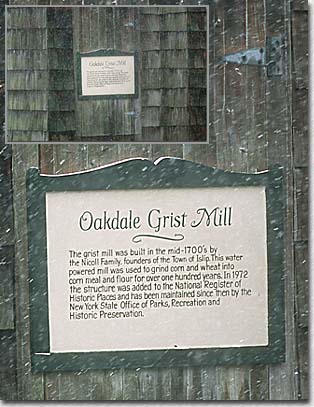 Tom Sobey, Sigma’s Marketing & Advertising Manager, arranged to have the 500/4.5 available for a weekend field test. The only caveat was the lens available for testing was in a Nikon mount, so Larry Castiglia was kind enough to loan me his F100.
Tom Sobey, Sigma’s Marketing & Advertising Manager, arranged to have the 500/4.5 available for a weekend field test. The only caveat was the lens available for testing was in a Nikon mount, so Larry Castiglia was kind enough to loan me his F100.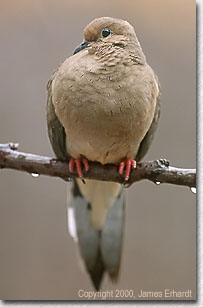 At this point, Larry and I called it quits as the wind picked up and the temperature continued to fall. Upon arriving home, I decided to test the lens on one of the strategically placed bird feeders I have in my yard. Strategically placed in that I can shoot through an open window from the comfort of my home. I positioned the gear at the closest focusing distance of the lens and waited for activity. The Sigma again showed its ability to focus quickly on fast moving song birds that would remain only for a second or two on the perch before they flew up to the feeder. The Sigma’s 4 to 8-meter focus limit setting was perfect for this application. The slower moving Mourning Dove gave me the opportunity to wait for a good pose. Since I was using Provia F 100 asa film, I shot the Sigma wide-open at f/4.5 and maintained shutter speed between 1/60th and 1/80th of a second. Even on a tripod, these speeds are at the lower limit for sharp images with a 500mm focal length lens. The ball head remained loose so I could follow the action at the feeder.
At this point, Larry and I called it quits as the wind picked up and the temperature continued to fall. Upon arriving home, I decided to test the lens on one of the strategically placed bird feeders I have in my yard. Strategically placed in that I can shoot through an open window from the comfort of my home. I positioned the gear at the closest focusing distance of the lens and waited for activity. The Sigma again showed its ability to focus quickly on fast moving song birds that would remain only for a second or two on the perch before they flew up to the feeder. The Sigma’s 4 to 8-meter focus limit setting was perfect for this application. The slower moving Mourning Dove gave me the opportunity to wait for a good pose. Since I was using Provia F 100 asa film, I shot the Sigma wide-open at f/4.5 and maintained shutter speed between 1/60th and 1/80th of a second. Even on a tripod, these speeds are at the lower limit for sharp images with a 500mm focal length lens. The ball head remained loose so I could follow the action at the feeder.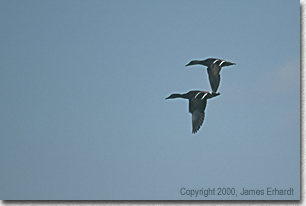 I really had no doubt that the slides would look great and verify what I saw through the viewfinder. I have become accustomed to the excellent results I get with my 300, so I figured anything close would be a great testament to the 500. Having only 52 frames through a lens is certainly not an exhaustive evaluation, but having shot thousands with my other lenses, this small sampling would at least give me a taste of what the Sigma 500/4.5 HSM is capable of.
I really had no doubt that the slides would look great and verify what I saw through the viewfinder. I have become accustomed to the excellent results I get with my 300, so I figured anything close would be a great testament to the 500. Having only 52 frames through a lens is certainly not an exhaustive evaluation, but having shot thousands with my other lenses, this small sampling would at least give me a taste of what the Sigma 500/4.5 HSM is capable of.